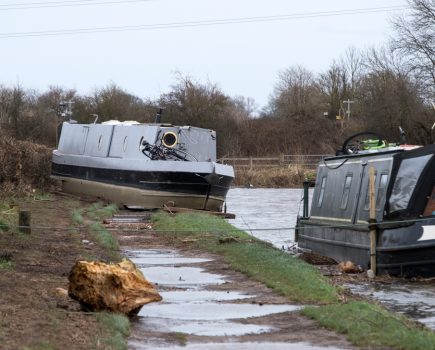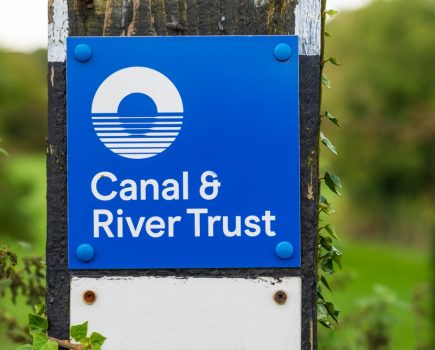Why is a highways body supporting a canal restoration to the tune of £4m? We follow the story of the M5 motorway and the ‘Missing Mile’…

As the forerunner of the Cotswold Canals restoration project was getting under way in the early 1970s, the dust had barely settled on a road construction scheme which had created one of the most serious obstructions to reopening the navigable route from the Severn to the Thames. But almost half a century later, the wheel has come full circle as the road builders’ successors have announced a £4m grant which will go a long way towards reinstating and reopening this difficult length of waterway.
The early 1970s were exciting times for canal restoration, with early schemes like the Stratford and Stourbridge already complete, others including the Cheshire Ring, Upper Avon and Caldon well on the way, and newer more difficult projects being launched such as the Rochdale, Huddersfield and Stroudwater. But in case of the last of these, the fortunes of the canal itself were at a low ebb. For the first two decade after abandonment in 1946, much of the Stroudwater Canal’s route from the Gloucester & Sharpness at Saul to Stroud (the western part of what we know today as the Cotswold Canals) had survived largely intact. But in the late 1960s the extension of the M5 motorway, and associated new link to the A38 dual carriageway, saw a mile of canal obliterated, and no navigable route provided under either of the main roads. The Stroudwater Canal Society took probably the only sensible way forward: they concentrated on the ‘easier’ bits, such as the section east of Eastington, and left the ‘missing mile’ for when more resources were available.

Fast forward to the second decade of the 21st Century. Stroudwater Canal Society has long since broadened its aims to become the Cotswold Canals Trust, aiming to reopen the Stroudwater and Thames & Severn canals all the way from Saul to Inglesham on the Thames. A major Lottery-funded programme is close to completing the isolated five miles from Stonehouse through Stroud to just short of Brimscombe. A £2m grant from the Government’s Homes & Communities Agency will regenerate Brimscombe Port to form a terminus for this stage. And a bid to the National Lottery Heritage Fund has already passed the first hurdle towards securing a further £9m towards a £20m-plus package to recreate the all-important ‘missing link’ connecting the restored lengths to the national network at Saul Junction – including the ‘missing mile’.
The Lottery money isn’t yet ‘in the bag’ – Lottery funds are oversubscribed, and there is still some ‘matching funding’ to confirm. But a major contribution towards filling the funding gap and starting work on this trickiest length has come from what seems an unlikely source: Government agency Highways England.
So why is a roads body paying for canal reopening? It’s a Government initiative to create funds aimed at reducing the social, economic and environmental impact of the major roads network on adjacent areas, bringing benefits and mitigating damage done in the past. One of these is the Environmental Fund: its aims include “improving the landscape’s quality”, “enhancing the biodiversity value” of “areas of wildlife value where our operations have left a long-term impact”, “reducing the road network’s impact on the historic environment”, “enhancing the condition of cultural heritage and historic features close to the road network” and “contributing to an improved quality of life for those living near our road network”.
And reinstating a mile of what had been restorable canal until the late 1960s, but was destroyed by road works just as the restoration movement was gaining momentum, ticks pretty much all the boxes. Highways England awarded £4m towards reinstating the ‘missing mile’.
What will this pay for? Primarily, the one main part of this length which will need to be done by contractors rather than volunteers: the new A38 crossing. Here, the lost canal bridge will be replaced by two new structures, passing diagonally under the roundabout where the A419 (the M5 link road built in the 1960s) meets the A38. That should leave sufficient to also fund some work on the remainder of the missing mile, where most of the construction will be done by volunteers from Cotswold Canals Trust supported by Waterway Recovery Group and other visiting teams.
Earlier this year, the Stroud Valleys Canal Company (a Stroud District Council body responsible for operating and maintaining the restored lengths of canal) put in a planning application for re-creation of this length. It goes into the detail of what they will need to build…
From the west end, the A38 roundabout crossing mentioned above will be followed by a new lock, a modern-style structure mainly built by volunteers using ‘Lego style’ large interlocking concrete blocks, and raising the canal approximately 1m.
This puts it at the right height to deal with the next obstruction: the M5. Passing a new mooring basin, the canal will veer to the south of its original course to come alongside the River Frome and share its bridge under the motorway. There is only about 1.5m of headroom above the river, but the canal will run alongside it at a lower level, the two channels separated by a wall, providing 2.5m headroom for boats. As there is no work needed on the actual bridge, it is hoped that volunteers can also carry out much of the work here.
Two options exist for the next length: both will involve a second new lock with about a 1.65m rise, but option ‘A’ stays close to the river for longer, while option ‘B’ diverges from it earlier and passes a second mooring basin. Either way, the new channel returns to the original route to pass under a surviving bridge and meet the remains of Westfield Lock.
This was partly demolished in the 1960s and a stream channel cut through the canal at the lock head: this will be replaced by a culvert or small aqueduct taking the canal over the stream, and the lock will be rebuilt – once again with a major volunteer involvement.
And the timescale? This will need to fit in both with Highways England’s annual budgetary considerations, and with the Lottery’s rules if it is to count as matching funding – always assuming the Lottery bid passes the final hurdle (with a decision due around March 2020). Even if it doesn’t pass, the Highways money is committed and this part of the work will take place anyway. And with initial preparations (tree clearance and ground investigation) already under way it seems likely that main construction of the A38 crossing could begin as early as autumn this year, with a 12-month completion schedule. And work on the remainder of the missing mile would carry straight on, with volunteers getting stuck in during 2020.
This would then leave the Lottery (fingers crossed!) and other match funding to complete the remainder of the four-mile length (the railway crossing and one more road bridge being the main expensive contractor jobs), for a potential reopening of ten miles of canal through from Saul to Brimscombe Port within five years.
And that’s a big step towards tackling the remaining 26 miles to get through to the Thames.
Image(s) provided by:
SDC







